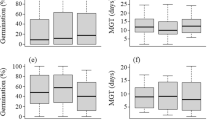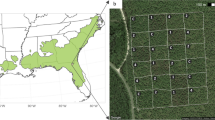Summary
The pollination biology as related to divergent post-fire reestablishment strategies was examined during flowering sequences for two years in sympatric populations of Arctostaphylos pringlei and A. glandulosa var. mollis. Arctostaphylos pringlei reestablishes post-fire populations by means of fire-stimulated germination of previously dormant seeds, while A. glandulosa var. mollis resprouts from large subsurface burls. Arctostaphylos pringlei produced more flowers per unit plant size, exhibited faster nectar production and higher nectar concentration, attracted nearly twice the number of pollinator visitations, and set more seed when self-pollinated. This substantiated the hypothesis that in these two species the amount of reproductive energy allocated to flower, nectar, and seed production reflected the relative significance of “seeding” compared to a “resprouting” post-fire establishment strategy.
Similar content being viewed by others
References
Carpenter, F.L., Recher, H.F.: Pollination, reproduction, and fire. Am. Nat. (in press)
Heinrich, B.: Energetics of pollination. Ann. Rev. Ecol. Syst. 6, 139–170 (1975)
Heinrich, B., Raven, P.H.: Energetics and pollination ecology. Science 176, 597–602 (1972)
Jepson, W.L.: Regeneration in manzanita. Madroño 1, 3–11 (1916)
Keeley, J.E.: Seed production, seed populations in soil, and seedling production after fire for two congeneric pairs of sprouting and nonsprouting chaparral shrubs. Ecology 58, 820–829 (1977)
Keeley, J.E., Zedler, P.H.: Reproduction of chaparral shrubs after fire: A comparison of sprouting and seeding strategies. Am. Midl. Nat. 99, 142–161 (1978)
Mosquin, T.: Competition for pollinators as a stimulus for the evolution of flowering times. Oikos 22, 398–402 (1971)
Munz, P.A., Keck, D.: A California Flora. Berkeley: University of California Press 1959
Nuñez, J.A.: The relationship between sugar flow and foraging and recruiting behavior of honeybees (Apis mellifera). Anim. Behav. 18, 527–538 (1970)
Sampson, A.W.: Plant succession on burned chaparral lands in northern California. Univ. Calif. College of Agric. Bull. 685 (1944)
Vogl, R.J., Schorr, P.K.: Fire and manzanita chaparral in the San Jacinto Mountains, California. Ecology 53, 1179–1188 (1973)
Wells, P.W.: Vegetation in relation to geological substratum and fire in the San Luis Obispo Quadrangle, California. Ecol. Monogr. 32, 79–103 (1962)
Wells, P.W.: The relationship between mode of reproduction and extent of speciation in woody genera of the California chaparral. Evolution 19, 264–267 (1969)
Went, F.W., Juhren, G., Juhren, M.C.: Five biotic factors affecting germination. Ecology 33, 351–364 (1952)
Author information
Authors and Affiliations
Rights and permissions
About this article
Cite this article
Fulton, R.E., Lynn Carpenter, F. Pollination, reproduction, and fire in California Arctostaphylos . Oecologia 38, 147–157 (1979). https://doi.org/10.1007/BF00346560
Received:
Issue Date:
DOI: https://doi.org/10.1007/BF00346560




